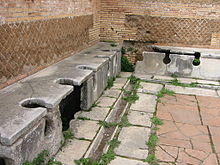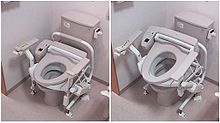Lavatory
It's called a toilet, closet, water closet, water closet, or toilet b> to the sanitary apparatus used to collect and evacuate solid and liquid human excrement towards a sanitation facility and that prevents, through a clean water siphon system, the exit of unpleasant odors from the sewer or sewer into the spaces inhabited. Odorless means that it does not smell.
Toilet bowls are generally made from porcelain, but also from stainless steel and any other smooth, impermeable material. The technology used for modern toilets varies; they are usually made of ceramic (porcelain), concrete, plastic, or wood. Newer toilet technologies include dual flush, low flush, heated toilet seat, self-cleaning, urinals, and waterless urinals. Japan is known for its bathroom technology. Airplane toilets are specially designed to work in the air. The need to maintain anal hygiene after defecation is universally recognized and toilet paper (often held by a toilet paper holder), which can also be used to clean the vulva after urination, is widely used (as is the bidet).).
In private homes, depending on the region and style, the toilet may exist in the same bathroom as the sink, tub, and shower. Another option is to have a room for washing the body (also called a "bathroom") and a separate room for the toilet and hand washing (bathroom). Public toilets consist of one or more toilets (and commonly individual urinals or channel urinals) that are available for use by the general public. Products like urinal blocks and toilet blocks help keep toilets smelling and clean. Toilet seat covers are sometimes used. Porta-potties (often chemical 'porta-pot') may be brought in for large, temporary gatherings.
Historically, sanitation has been a concern since the earliest stages of human settlement. However, many poor households in developing countries use very basic and often unhygienic toilets, and almost a billion people do not have access to a toilet at all; they must openly defecate and urinate. Or they must resort to a "flying toilet": a plastic bag. These problems can lead to the spread of diseases transmitted through the fecal-oral route, or the transmission of waterborne diseases such as cholera and diarrhoea. Therefore, the United Nations Sustainable Development Goal 6 wants to "achieve access to adequate and equitable sanitation and hygiene for all and end open defecation".
Evolution
Quevedo, in a scene of the Buscón called Don Pablos, indicates the use of the “service” to evacuate. This consisted of a kind of potty that collected the excrement or urine and that was emptied directly on the public highway with the prior notice: "Water goes!" The room or room where the potty was kept was also called "service"., what would later be called a "toilet".
John Harington described in 1596 a predecessor of the toilet that was emptied by a valve.
The hydraulic closing system with a siphon, or S-shaped tube, was patented by Alexander Cumming in 1775.
Denominations
The name "toilet" comes from the fact that it is the first sanitary device that had a siphon to prevent odors from escaping, which was much more necessary than in previous devices, which is why it was already connected to the sewer. Before the appearance of this system, it was obviously smelly, and it was locked in a small room, exclusively for that use, which had the name of toilet (which comes from retirete, small withdrawal). As in any case, after use, odors remain in the room, in cold countries this separation was kept in a specific room, which could be ventilated without the need to cool the air in the toilet or bathroom, which is common Undress. The rest of the devices also adopted the hydraulic closure, so, theoretically, they could also be called toilets.
Other denominations
- Bacínin Yucatan.[chuckles]required]
- BazaCantabria.
- Escusado or its written variant with “x”, excused.
- Pocetain Venezuela, referring to the old method of eliminating excrements: in a well.
- Retrete, word meaning ‘small retreat’ (chuckles) and therefore it would have to refer more to the reduced place where the toilet is put.
- Health.
- Service.
- Taza or bath cup.
- Váter or WC (pronouncing English watersometimes as a "vater").
- Wáter clóset or WCwhich comes from the English term water closet (‘armario or cabinet of water’), referring to the small room and the artifact contained therein where human waste was deposited, which corresponds more or less to the Spanish term retrete.
Operation
The peculiarity of the water toilet is that it has a angled drain, so that water is retained in it, forming a hydraulic seal or siphon, which prevents the passage of unpleasant odors. The dragging of organic matter to sanitation requires a device that produces a discharge of a large flow of water in a very short time, leaving nothing more than clean water in the elbow of the hydraulic closure. This device can be a cistern or a special valve called a flushometer.
The cisterns, which can be high (fixed to the wall at a height of almost two meters) or low, have a filling mechanism, with a level valve, which cuts off the water inlet when it reaches a level determined, and another download, activated by the user. Due to its position, the high cistern requires less water to function.
In some public toilets and hotels, to avoid vandalism, flush-mounted cisterns are used behind the wall that supports the toilet, located higher than the low cistern and less than the high one, so that only the cistern can be seen the activation button, being large enough to serve as a register of the cistern for repairs.
In collective toilets, where the frequency of use may be high, flushometers are used, which avoid having to wait the necessary time to fill the cistern between one use and the next. However, the use of this device should be limited, because it requires larger diameter pipes and, if the installation has many devices of this type connected, it may require its own installation, different from the normal one. On the contrary, it has the advantage, in collective public toilets, that it is more difficult to damage it by vandalism.
Types of toilets
The different categories of toilets include:
- Pedestal toilet: most toilets are of this type. It consists of a seat fixed to the ground by buns or another removable piece.
- Toilet suspended: the cup is fixed to the wall by means of a metal angular armor embedded on the wall and floor. It has the great advantage of leaving the soil completely free, which facilitates cleaning.
- Toilet to the Turkish, Turkish toilet or Turkish plate: it is a cupless toilet: a hole on the floor, with two adjacent sites to support the feet. You can still have a hydraulic shutdown.
How to use
The pedestal toilet is designed so that the user uses it in a sitting position for both defecation and urination. Therefore, it has a height of around 40 cm (centimeters) and a special plate to support the thighs comfortably.
However, it is traditional for men to use it in a standing position to urinate using the penis to direct the urine into the device. There are opinions that question this use by men: most of the advice to teach children to use the artifact and the proposals of some politicians. According to these proposals, the reasons for encouraging men to use the toilet in a sitting position are to have "bathrooms free of puddles and splashes" and the fact that this position empties the bladder more efficiently and reduces the risk of prostate problems. Proposals of this type have been made by Viggo Hansen of the Swedish Left Party and Taiwanese minister Stephen Shen. The device designed to urinate in a standing position is the urinal.
Environmental impact
When someone decides to use the toilet, they are inevitably polluting the water. It is estimated that a family of five that uses it contaminates more than 150,000 L (liters) of water by transporting about 250 kg (kilograms) of feces and 2,500 L of urine in a year.[citation required]
Wastewater treatment plants (WTPs) can help minimize the negative environmental impact that this can cause, reducing the spread of infectious diseases (such as gastroenteritis and cholera, among others), but, in 90% of the cases in the world, wastewater does not receive treatment and goes directly into the environment. In addition, there are many types of drugs and other chemicals that cannot be reliably disposed of in WWTPs.
The provision of toilets as part of sanitation interventions contributes to improving health and social development outcomes. A review of various studies conducted in Africa, Asia and Latin America concluded that sanitation and hygiene interventions reduce the risk of diarrhoea, leading to a decrease in morbidity of 37% on average.
Criticism of the design to evacuate sitting down
Some experts suggest that the Western toilet, which is currently the most widespread, is poorly designed, forcing the user to sit down to defecate. Apparently, this position is not the most efficient or the most hygienic to fulfill this physiological need, since the human organism has not evolved to defecate in the sitting position, but in a squatting position, like other primates. Defecate Sitting entails a greater expenditure of body oxygen, especially in asthmatics or the elderly with respiratory diseases and may be deprived of oxygen by having to support their own weight, the solution is to defecate squatting but that the body is supported by an ergonomic seat.
Alternatives
The field of ecological sanitation offers other ways to treat excreta, without contaminating the environment and taking advantage of the material as a valuable resource. There are dry ecological toilets with urine separation and dry toilets that use absorbent material instead of water. The ArborLoo are very economical and allow fertilizing the land where trees are going to be planted, instead of generating sewage that pollutes rivers and seas.
Note
- ↑ Escusado is the etymological graph, however the graph has become frequent excused by crossing with the verb "excusar".








